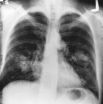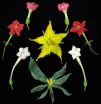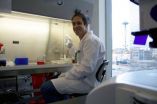(Press-News.org) How can solar energy be stored so that it can be available any time, day or night, when the sun shining or not? EPFL scientists are developing a technology that can transform light energy into a clean fuel that has a neutral carbon footprint: hydrogen. The basic ingredients of the recipe are water and metal oxides, such as iron oxide, better known as rust. Kevin Sivula and his colleagues purposefully limited themselves to inexpensive materials and easily scalable production processes in order to enable an economically viable method for solar hydrogen production. The device, still in the experimental stages, is described in an article published in the journal Nature Photonics.
The idea of converting solar energy into hydrogen is not a new one; researchers have been working on it for more than four decades. During the 1990s, EPFL joined the fray, with the research of Michaël Grätzel. With a colleague form University of Geneva, he invented the photoelectrochemical (PEC) tandem solar cell, a technique for producing hydrogen directly from water. Their prototypes shared the same basic principle: a dye-sensitized solar cell – also invented by Michael Grätzel – combined with an oxide-based semiconductor.
The device is completely self-contained. The electrons produced are used to break up water molecules and reform the pieces into oxygen and hydrogen. In the same liquid, two distinct layers in the device have the job of generating electrons when stimulated by light; an oxide semiconductor, which performs the oxygen evolution reaction, and a dye-sensitized cell, which liberates the hydrogen.
The most expensive part? The glass plate
The team's latest prototype focused on resolving the main outstanding problem with PEC technology: its cost. "A U.S. team managed to attain an impressive efficiency of 12.4%," says Sivula. "The system is very interesting from a theoretical perspective, but with their method it would cost 10,000 dollars to produce a 10 square centimeter surface."
So the scientists set themselves a limitation from the start – to use only affordable materials and techniques. It wasn't an easy task, but they managed. "The most expensive material in our device is the glass plate," explains Sivula. The efficiency is still low – between 1.4% and 3.6%, depending on the prototype used. But the technology has great potential. "With our less expensive concept based on iron oxide, we hope to be able to attain efficiencies of 10% in a few years, for less than $80 per square meter. At that price, we'll be competitive with traditional methods of hydrogen production."
The semiconductor, which performs the oxygen evolution reaction, is just iron oxide. "It's a stable and abundant material. There's no way it will rust any further! But it's one of the worst semiconductors available," Sivula admits.
Silicon-enhanced nano-rust
That's why the iron oxide used by the team is a bit more developed than what you'd find on an old nail. Nanostructured, enhanced with silicon oxide, covered with a nanometer-thin layer of aluminum oxide and cobalt oxide – these treatments optimize the electrochemical properties of the material, but are nonetheless simple to apply. "We needed to develop easy preparation methods, like ones in which you could just dip or paint the material."
The second part of the device is composed of a dye and titanium dioxide – the basic ingredients of a dye-sensitized solar cell. This second layer lets the electrons transferred by the iron oxide gain enough energy to extract hydrogen from water.
An outstanding potential – up to 16%
The results presented in the Nature Photonics paper represent a breakthrough in performance that has been enabled by recent advances in the study of both the iron oxide and dye-sensitized titanium dioxide, and both of these technologies are rapidly advancing. Sivula predicts that the tandem cell technology will eventually be able to attain an efficiency of 16% with iron oxide, while still remaining low cost, which is, after all, the attractiveness of the approach. By making it possible to store solar energy inexpensively, the system developed at EPFL could considerably increase the potential of solar energy to serve as a viable renewable energy source for the future.
### END
Using rust and water to store solar energy as hydrogen
EPFL scientists are producing hydrogen from sunlight, water and rust - They're paving the way for an economic and ecological solution for storing renewable energy
2012-11-12
ELSE PRESS RELEASES FROM THIS DATE:
A better brain implant: Slim electrode cozies up to single neurons
2012-11-12
ANN ARBOR—A thin, flexible electrode developed at the University of Michigan is 10 times smaller than the nearest competition and could make long-term measurements of neural activity practical at last.
This kind of technology could eventually be used to send signals to prosthetic limbs, overcoming inflammation larger electrodes cause that damages both the brain and the electrodes.
The main problem that neurons have with electrodes is that they make terrible neighbors. In addition to being enormous compared to the neurons, they are stiff and tend to rub nearby cells ...
Gene variations linked to lung cancer susceptibility in Asian women
2012-11-12
An international group of scientists has identified three genetic regions that predispose Asian women who have never smoked to lung cancer. The finding provides further evidence that risk of lung cancer among never-smokers, especially Asian women, may be associated with certain unique inherited genetic characteristics that distinguishes it from lung cancer in smokers.
Lung cancer in never-smokers is the seventh leading cause of cancer deaths worldwide, and the majority of lung cancers diagnosed historically among women in Eastern Asia have been in women who never smoked. ...
Detection, analysis of 'cell dust' may allow diagnosis, monitoring of brain cancer
2012-11-12
A novel miniature diagnostic platform using nuclear magnetic resonance (NMR) technology is capable of detecting minuscule cell particles known as microvesicles in a drop of blood. Microvesicles shed by cancer cells are even more numerous than those released by normal cells, so detecting them could prove a simple means for diagnosing cancer. In a study published in Nature Medicine, investigators at the Massachusetts General Hospital (MGH) Center for Systems Biology (CSB) demonstrate that microvesicles shed by brain cancer cells can be reliably detected in human blood through ...
Researchers discover 2 genetic flaws behind common form of inherited muscular dystrophy
2012-11-12
SEATTLE – An international research team co-led by a scientist at Fred Hutchinson Cancer Research Center has identified two genetic factors behind the third most common form of muscular dystrophy. The findings, published online in Nature Genetics, represent the latest in the team's series of groundbreaking discoveries begun in 2010 regarding the genetic causes of facioscapulohumeral muscular dystrophy, or FSHD.
The team, co-led by Stephen Tapscott, M.D., Ph.D., a member of the Hutchinson Center's Human Biology Division, discovered that a rare variant of FSHD, called type ...
Touch-sensitive plastic skin heals itself
2012-11-12
Nobody knows the remarkable properties of human skin like the researchers struggling to emulate it. Not only is our skin sensitive, sending the brain precise information about pressure and temperature, but it also heals efficiently to preserve a protective barrier against the world. Combining these two features in a single synthetic material presented an exciting challenge for Stanford Chemical Engineering Professor Zhenan Bao and her team.
Now, they have succeeded in making the first material that can both sense subtle pressure and heal itself when torn or cut. Their ...
36 in one fell swoop -- researchers observe 'impossible' ionization
2012-11-12
This press release is available in German.
Using the world's most powerful X-ray laser in California, an international research team discovered a surprising behaviour of atoms: with a single X-ray flash, the group led by Daniel Rolles from the Center for Free-Electron Laser Science (CFEL) in Hamburg (Germany) was able to kick a record number of 36 electrons at once out of a xenon atom. According to theoretical calculations, these are significantly more than should be possible at this energy of the X-ray radiation. The team present their unexpected observations in the ...
'Groundwater inundation' doubles previous predictions of flooding with future sea level rise
2012-11-12
Scientists from the University of Hawaii at Manoa (UHM) published a study today in Nature Climate Change showing that besides marine inundation (flooding), low-lying coastal areas may also be vulnerable to "groundwater inundation," a factor largely unrecognized in earlier predictions on the effects of sea level rise (SLR). Previous research has predicted that by the end of the century, sea level may rise 1 meter. Kolja Rotzoll, Postdoctoral Researcher at the UHM Water Resources Research Center and Charles Fletcher, UHM Associate Dean, found that the flooded area in urban ...
Game changer for arthritis and anti-fibrosis drugs
2012-11-12
(SALT LAKE CITY)—In a discovery that can fundamentally change how drugs for arthritis, and potentially many other diseases, are made, University of Utah medical researchers have identified a way to treat inflammation while potentially minimizing a serious side effect of current medications: the increased risk for infection.
These findings provide a new roadmap for making powerful anti-inflammatory medicines that will be safer not only for arthritis patients but also for millions of others with inflammation-associated diseases, such as diabetes, traumatic brain injury, ...
CSHL-led team discovers new way in which plants control flower production
2012-11-12
Cold Spring Harbor, N.Y. – Flowers don't just catch our eyes, they catch those of pollinators like bees as well. They have to, in order to reproduce. Because plants need to maximize the opportunity for pollinators to gain access to their seeds, variations in the timing of flowering can have profound effects on flower, fruit, and seed production, and consequently agricultural yields.
We know that the major driving forces of flowering are external factors such as light and temperature. However, new research from CSHL Assistant Professor Zach Lippman, Ph.D. and his collaborators, ...
Mutations in genes that modify DNA packaging result in Facioscapulohumeral Muscular Dystrophy
2012-11-12
A recent finding by medical geneticists sheds new light on how Facioscapulohumeral Muscular Dystrophy develops and how it might be treated. More commonly known as FSHD, the devastating disease affects both men and women.
FSHD is usually an inherited genetic disorder, yet sometimes appears spontaneously via new mutations in individuals with no family history of the condition.
"People with the condition experience progressive muscle weakness and about 1 in 5 require wheelchair assistance by age 40," said Dr. Daniel G. Miller, University of Washington associate professor ...
LAST 30 PRESS RELEASES:
Making lighter work of calculating fluid and heat flow
Normalizing blood sugar can halve heart attack risk
Lowering blood sugar cuts heart attack risk in people with prediabetes
Study links genetic variants to risk of blinding eye disease in premature infants
Non-opioid ‘pain sponge’ therapy halts cartilage degeneration and relieves chronic pain
AI can pick up cultural values by mimicking how kids learn
China’s ecological redlines offer fast track to 30 x 30 global conservation goal
Invisible indoor threats: emerging household contaminants and their growing risks to human health
Adding antibody treatment to chemo boosts outcomes for children with rare cancer
Germline pathogenic variants among women without a history of breast cancer
Tanning beds triple melanoma risk, potentially causing broad DNA damage
Unique bond identified as key to viral infection speed
Indoor tanning makes youthful skin much older on a genetic level
Mouse model sheds new light on the causes and potential solutions to human GI problems linked to muscular dystrophy
The Journal of Nuclear Medicine ahead-of-print tip sheet: December 12, 2025
Smarter tools for peering into the microscopic world
Applications open for funding to conduct research in the Kinsey Institute archives
Global measure underestimates the severity of food insecurity
Child survivors of critical illness are missing out on timely follow up care
Risk-based vs annual breast cancer screening / the WISDOM randomized clinical trial
University of Toronto launches Electric Vehicle Innovation Ontario to accelerate advanced EV technologies and build Canada’s innovation advantage
Early relapse predicts poor outcomes in aggressive blood cancer
American College of Lifestyle Medicine applauds two CMS models aligned with lifestyle medicine practice and reimbursement
Clinical trial finds cannabis use not a barrier to quitting nicotine vaping
Supplemental nutrition assistance program policies and food insecurity
Switching immune cells to “night mode” could limit damage after a heart attack, study suggests
URI-based Global RIghts Project report spotlights continued troubling trends in worldwide inhumane treatment
Neutrophils are less aggressive at night, explaining why nighttime heart attacks cause less damage than daytime events
Menopausal hormone therapy may not pose breast cancer risk for women with BRCA mutations
Mobile health tool may improve quality of life for adolescent and young adult breast cancer survivors
[Press-News.org] Using rust and water to store solar energy as hydrogenEPFL scientists are producing hydrogen from sunlight, water and rust - They're paving the way for an economic and ecological solution for storing renewable energy




